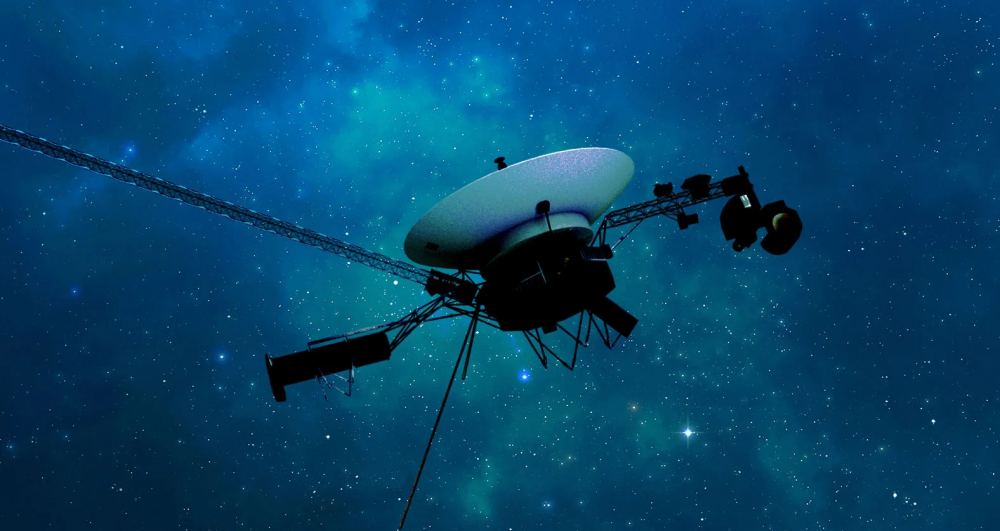The venerable Voyager 1 spacecraft is finally phoning home again. This is much to the relief of mission engineers, scientists, and Voyager fans around the world.
On November 14, 2023, the aging spacecraft began sending what amounted to a string of gibberish back to Earth. It appeared to be getting commands from Earth and seemed to be operating okay. It just wasn’t returning any useful science and engineering data. The team engineers began diagnostic testing to figure out if the spacecraft’s onboard computer was giving up the ghost. They also wanted to know if there was some other issue going on.
It wasn’t completely surprising that Voyager 1 would have issues, after all. And, this isn’t the first time Voyager 1 has sent back garbly data. It’s been traversing space since its launch in 1977. Currently, the spacecraft is rushing away from the Solar System toward interstellar space. The spacecraft systems will eventually fail due to age and lack of power. But, people have always held out hope for them to last as long as possible. That’s because Voyager 1 is probing unexplored regions of space.
What Happened to Voyager 1?
The diagnostic testing led the engineering team at NASA’s Jet Propulsion Laboratory to look at old engineering documents and manuals for the onboard computers. Eventually, they found that the flight data subsystem (FDS) was having an issue. In the spacecraft’s data handling pipeline, this system takes information from the instruments and packages it into a data stream for the long trip back to Earth.
It turns out that the FDS has a bit of a memory problem. The engineers found this out by poking at the computer—literally sending a “poke” command to Voyager 1. That prompted the FDS to disgorge a readout of its memory—including the software code and other code values. The readout showed that about 3 percent of the FDS memory is corrupted due to a single chip failing. That’s just enough to keep the computer from doing its normal work of packaging science and engineering data. Unfortunately, engineers can’t replace the chip. No repair is possible, so the technical team devised a workaround.
Fixing the Faulty Code and Chip
So, how did engineers reach across 24 billion kilometers of space to restore communication with Voyager 1? They focused on a specific part of the computer. The loss of the code on that failed chip made it impossible for the computer to do its job. So, they figured out a way to divide the code into sections and store them in various locations around the FDS. Then they had to make the sections work together to do their original job.
They started out by taking the code that packages engineering data and moving it to a safe spot in FDS. Then they sent some commands to the spacecraft for the FDS to do some tasks. That worked because, on April 20th, they heard back from the spacecraft with clear, intelligible data. Now, they just need to do the same thing with other bits of code so that the spacecraft can send back both engineering and science data.

For now, at least, the science and engineering teams can check the spacecraft’s health and its systems. Once they relocate the other bits of code and test them after being moved, they should be able to start receiving science data again. This could take several weeks to accomplish. They’re communicating with a spacecraft that’s 22.5 light-hours away, so having a lengthy diagnostic conversation with Voyager is going to take some time. This isn’t the only problem engineers have had to contend with recently with Voyager 1. In October 2023, they worked to overcome a fuel flow problem affecting its thrusters.
Voyager 1 Into History
Voyager 1 was launched on a planetary flyby trajectory on September 5, 1977. It passed by Jupiter in March 1979 and Saturn in November 1980. The mission then morphed into an extended period of exploration and exited the heliopause in 2012. On its way out of the Solar System, the spacecraft also “looked back” at Earth. Now, it’s exploring the interstellar medium but has not yet traversed the Oort Cloud, the outermost portion of the Solar System.

Several of Voyager 1’s science instruments are shut down, including its ultraviolet spectrometer, the plasma subsystem, planetary radio astronomy instrument, and scan platform. In the not-too-distant future, more instruments will be powered down, along with the data tape recorder, the gyroscopes, and other systems will be off. Sometime in the next decade, the spacecraft won’t have enough power to keep anything running, and that is when we’ll finally lose contact with Voyager 1.
This will probably happen by the mid-2030s, and by that time, Voyager 1 will have been “in service” for around 55 years. Along with its twin, Voyager 2, this spacecraft opened up exploration of the outer solar system and interstellar space. They’ll continue out to the stars, their last mission being as a calling card to any civilizations that might find them in the distant future.
For More Information
NASA’s Voyager 1 Resumes Sending Engineering Updates to Earth
Engineers Pinpoint Cause of Voyager 1 Issue, Are Working on Solution


The happiness and relief is palpable.
And shared.